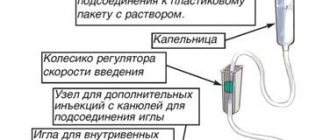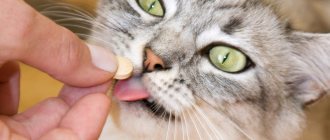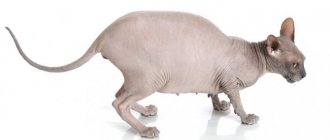How to put an IV on a dog?
I decided to write a detailed article on how to put an IV on a dog, especially for my friends, so that they would have a small and understandable guide, a manual, so to speak. Now, it seems to me that assembling the system is quite simple, but when I had to do it for the first time, everything did not work out as it should, either the solution did not want to drip, or on the contrary, it ran too quickly, in general, there were difficulties.
Let's learn from my past mistakes so as not to make our own and figure out how to properly assemble an intravenous infusion system, find out why and how to put an IV in a dog, what its benefits are.
Assembling our design
When you print the system, you will see a flexible transparent tube, on one side there is a needle or a plastic tip (depending on the manufacturer), this needle (tip) must be inserted into the bottle with the solution. As you can see in the photo.
insert the needle into the bottle until it stops
Often a dog has to be given an IV at home, so it is convenient to use improvised objects, such as a mop, stepladder, furniture, adhesive tape or electrical tape. You won’t be carrying a special tripod with you. In this case, I used the handle of the Orbitrek simulator.
At the other end of the tube there is a cuff or valve, made of soft rubber, into which, if necessary, drugs are injected, immediately behind it is a plastic cannula. The cannula has a standard size, so it fits needles from a disposable syringe or catheter.
we see a catheter with a connected system and a cuff
The system also has a dispenser - a plastic thing with a wheel. Before you fill the IV, move it closer to the end with the cannula so that you can easily adjust the slider during the procedure. Now move the wheel all the way to push the tube.
Now let's go back to the second image, you see here, in addition to the large needle, I stuck a small one so that air could enter the bottle, without it the solution will stop dripping. Let's remember school and physics.
But when you closed the valve, inserted the second needle, now press on the tube - this is a slight expansion as in the photo.
Special extension on the system
Now move the wheel on the dispenser little by little to completely fill the system with solution until it begins to flow out of the cannula. While assembling my first dropper, I did not turn off the dispenser and began to press the tube; as a result, air got into the system, which I was tormented to expel.
Move the wheel on the dispenser
Why is an IV needed?
We have already figured out how to put an IV on a dog, but it is not clear why it is needed. I couldn’t find a specific and understandable answer to this question on the Internet, maybe you’ll have better luck. In the meantime, I’ll write a few of my explanations.
If we give a general definition, then intravenous administration of fluid, the required salt composition, helps to avoid or “mitigate” a critical condition.
Let's give a few examples.
The puppy diarrhea and vomits every hour, pouring water through his mouth is pointless, it simply does not have time to be absorbed - dehydration develops.
The dog has been poisoned, we need to remove toxins from the blood as soon as possible, again an IV will help us.
Or another example: while walking you catch an infectious tick - piroplasmosis begins, as a result, red blood cells are destroyed, the blood thickens, toxins accumulate, and the gas balance of the blood is disturbed.
And with the help of intravenous infusions, we will quickly remove poisons, reduce blood viscosity, and normalize blood pressure.
Our actions will influence the functioning of the heart, it will become easier for it to pump blood, and if the heart is lighter, then other organs will receive more oxygen and nutrition. As we see, everything in the body is interconnected.
The dropper has a positive effect in many diseases; it often helps out in doubtful cases. We manage to save an animal that is in critical condition for unknown reasons.
Those people who came up with an intravenous infusion system and a catheter made the doctor’s work easier, and the owner can now independently administer an IV to the dog, thanks to them.
Fears associated with IV drips
Many people have fears associated with intravenous injections, the most common of which is air in the vein! What if an air bubble gets in during the injection, then the dog will die from an embolism. In fact, in order to kill an animal in this way, you need to introduce quite a lot of air, and into important vessels.
Several times I heard a terrible story about how a nurse put in an IV and forgot about the patient, the medicine ran out, and air went into the vein. Quite scary, but this will never happen because there is pressure in the blood vessels. You can put an IV on your dog and forget about it, the fluid in the system will drop to a certain level and stop dripping, that’s all.
We pierce the rubber cuff and inject the drug
The second phobia is associated with a blood clot in the catheter; people are afraid that the blood clot will break off and block the blood vessels of the brain or cause cardiac paralysis.
Yes, blood clots are dangerous if they are large or formed in the brain, but the clot in the catheter is very small. Also take into account the length of the path from the paw to the head; during the journey, the clot will have time to dissolve several times.
Blood clots form almost every day after a worm strikes or moves, so the body knows how to fight them.
Another phobia is associated with the installation of a catheter; people are afraid that a needle will stick out in the animal’s vein. But it’s not there, it’s only needed for puncture and insertion of the catheter. After installation, the needle (called a stylet) is removed and a thin plastic tube remains in the paw, which bends easily and does not cause harm.
To put a drip on a dog without consequences, you need
Most fears associated with intravenous injections are myths, but some rules should be followed.
Be sure to adhere to the speed of introducing solutions; it is better to drip slowly. On average 1-2 drops per second. If the dog begins to breathe rapidly or has convulsions, then you need to reduce the speed of the drip or stop it completely for a few minutes.
All administered drugs must be warmed up so as not to overcool the body, and warm solutions also reach their destination faster. If you are administering a small dose, then the vial or syringe can be immersed in warm water. But when you need to drip a lot and for a long time, this is especially true in the cold season - lower part of the system into a container with warm water, as shown in the photo.
Warm up the injected solution
Be sure to cover your dog. You will notice that your pet will be capricious and fidgety for the first 5-10 minutes, and then will doze off and begin twitching, snoring and may pass gas. This is a normal phenomenon; most dogs fall asleep and dream while on a drip, so do not be alarmed and do not confuse this condition with seizures.
Conclusion
Source: https://vetdoc.in.ua/kak-postavit-kapelnicu-sobake.htm
Why you can't avoid injections
Even native breeds and disease-resistant artificially bred dogs. Laikas, Malamutes, Akitas, Schnauzers - if kept improperly or inbreeding, they produce very sickly offspring.
The healthiest dog can get sick - due to poisoning, a tick bite, injury, or severe childbirth. Therefore, knowing how to treat your dogs is important. It is difficult to force a dog to take a pill; they often vomit due to a hard, small object with an unpleasant taste getting into their mouth. Suspensions and syrups are often not suitable for dogs due to the risk of developing allergies. The active ingredient is included in the drug along with flavors, dyes, taste improvers, which are strong allergens. Not all medications prescribed to dogs are available in oral form.
Know how to give injections to a dog:
- This is assistance to the animal until the veterinarian arrives or until the dog is taken to the veterinary clinic. In emergency cases - poisoning, arrest of labor, heart attack, suffocation - this allows you to save the life of the animal;
- This will save money, since injection services are expensive, it is better to buy syringes, medications and inject the dog yourself. In addition, sometimes dogs have to be transported to the clinic by taxi, which is also expensive;
- This will allow you not to change your plans. If the pet is prescribed a course of treatment, then the owner’s ability to perform injections will not interfere with going to the country or on vacation with the dog, if, of course, it feels well and can do without constant monitoring of its health by a veterinarian;
- This has a beneficial effect on the animal, which may be tired of trips to the veterinary clinic, and the manipulations of a stranger cause stress.
- In general, the ability to inject your dog yourself is a very useful and necessary skill that any dog owner should master.
How to give an injection to a dog at the withers
Injections into the withers are called subcutaneous. A very large number of drugs prescribed to animals are administered subcutaneously due to low pain for dogs and ease of administration. Therefore, the owner needs to know how to give an injection in the withers of a dog, cat and other pets. Here's how to properly inject a dog at the withers:
- Fill the syringe with medicine;
- By pressing the plunger, remove air from the syringe until a drop of medicine appears from the needle hole;
- With one hand, pull the skin into a “house” at the withers in the area of the shoulder blades - the protruding bones where the neck ends and the back begins;
- If the dog has thick hair, it needs to be blown to the sides or straightened with your hand;
- Insert the needle into the recess of the “house” parallel to the spine and without piercing the fold of skin all the way through, using slow, constant pressure (a sharp insertion will cause it to bend on the thick dog skin). Press the plunger and inject the product into the skin at the speed recommended by the veterinarian.
We give injections into the muscle
Intramuscular injections are also common in veterinary practice, so the owner of the animal should know how to inject a dog intramuscularly:
- Draw up the medicine and remove air from the syringe;
- Mark the thickest area between the knee and hip joint;
- Insert the needle with a sharp movement - immediately to the desired depth (1/2 - 1 cm for small and medium-sized dogs, 1.5 - 2.5 cm for large and giant breeds).
- Inject the medicine at the required speed, but usually intramuscular injections are given slowly.
How injections into a vein are made
Owners are not taught how to give intravenous injections to dogs. This is technically difficult to perform, so if your pet is indicated for a course of injections into a vein, you should contact your veterinarian every time. If this is not possible, for example, the dog has a hard time traveling, or it is very large and cannot move, as a result, it is difficult to transport, then it is permissible to give intravenous injections yourself.
It will be interesting about the dog’s pedigree
You should ask the veterinarian to install a catheter on the dog’s paw, calculate the dosage of drugs for each injection and show how to properly administer the medicine in this case. The catheter will allow you to inject the medicine precisely into the vein and regulate the speed of administration (some drugs are injected slowly, others need to be injected quickly). In addition, the drug enters directly into the bloodstream, which means it begins to act a few seconds after the injection.
The mechanism of intravenous injection is as follows:
- The syringe is filled with medicine in a suitable quantity;
- By pressing the syringe plunger, air bubbles are removed;
- The bandage covering the hole with a valve is removed from the catheter;
- The syringe needle is inserted into the opening of the catheter;
- By pressing the piston, the medication is injected while maintaining the rate of administration;
- The catheter opening is closed with a valve or a fresh bandage.
After an intravenous injection, the dog may take care of its paw for some time, limp on it, or not use it when walking. This is considered normal if it goes away within an hour or two after the injection. If you have been protecting the paw for a longer period of time, the limb is swollen, or a vein is pulsating on it, then you should immediately contact your veterinarian.
Dropper for dogs: types, rules of procedure
Unfortunately, most of us have had to deal with illness in a pet. The animal will not say what and where it hurts, so it often comes to the veterinarian in critical condition.
The fastest and most effective way to administer the necessary medication to a patient is through infusion therapy.
Therefore, the doctor often uses droppers to quickly help the animal and alleviate the symptoms of the disease.
Treatment with IVs is often used to administer antibiotics or saline. Usually the treatment is scheduled for several days, that is, one procedure is not enough. If it is not possible to visit the veterinarian every day for the procedure, then an IV is placed at home.
Types of droppers
First of all, you need to know that the technique of placing an IV for a person and a dog are different things. IVs with saline are often placed subcutaneously, especially in small pets.
To do this, simply lift the skin at the withers and insert a needle. At first, a small compaction with liquid forms under the skin, but soon it disperses. During the procedure, the animal is held by the owner or employee of the veterinary clinic.
At the end of the infusion, the needle simply needs to be pulled out from under the dog's skin.
The second type of drip is intravenous administration of medication. Most often performed on large or medium-sized dogs. Keeping such an animal with a needle in a vein can be problematic, so the doctor usually suggests installing an intravenous catheter, which greatly facilitates the process.
A catheter is a small tube that goes into a vein along with a needle and remains there after it is removed. It is usually installed in the dog’s front paw and stays in the vein for a week.
Preparing for infusion
Regardless of what type of IV you choose, there are some preparations you need to make.
First, decide on the location of the procedure. This could be a table or a low couch. Based on your patient's size. The selected location must be clean and sterile. Therefore, be sure to treat the surface with alcohol or another disinfectant.
Prepare tools and materials . You will need:
- medications prescribed by the doctor;
- drip insertion system;
- alcohol;
- cotton wool;
- sterile gloves;
- tripod;
- syringe;
- patch.
All of the above can be placed on a tray, it will be more convenient.
To install an IV, you need a tripod , which hardly every person has; at home, it can be replaced with a hanger, stand, and similar devices.
A bag or bottle with medicine attached to the system is attached to the stand. The medicine bottle must be fixed at a height of at least 1.5 meters above the floor.
The system is a plastic tube with a reservoir , which has needles at both ends. One needle is injected into the patient intravenously, and the second is inserted into a bottle of medicine.
It is through this tube that the medicine enters the person’s blood. It also has a regulator that controls how quickly the medicine will drip.
There is one more extra needle in the intravenous infusion set: it is inserted into the bottle of medicine so that a vacuum is not created in it.
Dropper assembly
The procedure for assembling the system is as follows:
- Wear gloves and treat your hands with antiseptic.
- Prepare a bottle of medicine and hang it on a tripod.
- Check your doctor's prescription: often the dropper is a saline solution to which other components are added.
- If necessary, open the ampoules with medications, draw the contents with a syringe and inject them into the sodium chloride solution.
- Print out the system for installing the dropper.
- Find the plastic tube and the regulator on it - it needs to be moved to the closed position. This is not difficult to do - the tube will seem to be pinched.
- Insert the needle into the cap of the bottle or a special hole in the bag with the injected solution.
- Remove the extra needle from the package and insert it next to the main one to prevent a vacuum from forming.
- Find a cylinder-shaped extension on the plastic tube. Press it several times - it is necessary that it is filled with the medicine to about half. Using this cylinder you will determine the rate of introduction of the solution.
Source: https://sobaki.guru/bolezni/kapelnitsa-dlya-sobaki
System for drip administration or - dropper
On one side it is connected to a catheter in a vein, and on the other it is inserted into a bottle with a solution. There is a wide plastic needle at one end (with an air duct) 1
, filter for retaining dust and air bubbles,
2
– the dropper itself.
At the other end of the tube there is an orange soft rubber unit 5 ending with a cannula 4 and a needle inserted into the vein. The needles are in special caps. The tube has a device 3
(clamp-regulator) for adjusting the speed of solution administration.
Installing an IV for a dog
The first thing an owner sees when looking for information on how to place an IV in a dog is “this is a clinical procedure, contact a veterinarian.”
Quite logically, a dropper involves intravenous administration of the drug, less often, subcutaneous administration, which means you will have to correctly insert the needle into the dog’s vein.
If you don't have any medical skills, this is a really risky undertaking, the first principle of treatment is do no harm!
So, your pet is in critical condition, there is no veterinary clinic nearby, doctors cannot be found either, and you can no longer put off help - there is no way out! You will have to give your dog an IV at home.
How does the drug drip system work?
The pharmacy sells a complete system for intravenous infusions, consisting of the following parts:
- The flexible tube is the main part, through which the drug descends from the container with the medicine to the needle.
- Intake needles (2 pcs.) – both are inserted into the rubber cap of the container with liquid for infusion. One needle is attached to the tube, the second with an expander - for the flow of air into the bottle with the medicine.
- The dispenser is a plastic box with a wheel or slider. Refishes the tube, adjusting the speed at which the liquid falls.
- The chamber - a container made of soft transparent plastic with a filter inside - prevents oxygen from entering the tube and, accordingly, into the blood.
- A cannula is a device for introducing additional medications into an infusion solution; it may look like a rubber pad or a plastic container. Equipped with a valve for a standard needle.
Note! Droppers with a reservoir (bag) for liquid are equipped with a valve for air intake, that is, the bag does not need to be pierced with a second needle.
Choosing a needle for infusion
- Infusion needles are disposable - in fact, these are exactly the needles that are attached to the system. They vary in length and thickness. For subcutaneous injection into the withers, for example, saline solution for dehydration, a long needle of medium thickness is used. Intravenous administration is more traumatic; you will need the thinnest needle of medium length.
- A disposable butterfly needle is thin and short, in human medicine it is used for insertion into small veins, that is, it is suitable for small dogs. In front of the expander, there are plastic “wings” that can be conveniently fixed by bending them to the paw.
- An intravenous catheter is a plastic tube that is inserted into a vein. The drug is administered through a catheter, after which the gateway is closed with a stopper. With proper care, the device can remain in the vein for 5-6 days.
Note! The catheter is installed only by a veterinarian, without experience, you can seriously damage the vein and nerve endings of the animal’s paw!
Unforeseen circumstances and possible consequences
Naturally, after such a procedure, the dog’s owner will be “on pins and needles.” The biggest fear is the incorrect administration of so-called calcium chloride. A lump has formed after an IV, the dog’s paw clearly hurts, the animal is worried:
- Novocaine, 0.5 cubes around the bump. The total amount is equal to the administered one, that is, 10 cubes of calcium chloride were dripped and injected with 10 cubes of novocaine.
- We also chop off half of the administered dose of calcium chloride - 5% sodium citrate.
- We immediately go to the veterinarian, “scaremongers” about calcium chloride, most often, do not convey all the possible negative consequences.
Note! Even a properly placed needle can come out of the vein due to the dog tensing and relaxing the muscle. Constantly monitor the insertion process and feel the area around the needle.
Allergic attack after a drip. The dog cannot breathe, its throat and lips are swollen.
If symptoms appear during the procedure: break the dispenser, tighten the paw with a tourniquet (no more than 15 minutes, constantly monitor the pulse and temperature of the limb). It is optimal to inject the paw with a 0.1% solution of adrenaline and inject it intramuscularly.
We calculate the dose by weight, a third for injection, the rest into the muscle. Prednisolone, calculated by weight, is administered intramuscularly into both hind legs, dividing the dose in half.
Source: https://goload.ru/ustanovka-kapelnitsy-dlya-sobaki/
Putting an IV on a cat
Let’s make a reservation right away that during emergency care you may need an intravenous injection, but believe me, giving an injection is easier than putting an IV on a cat at home - we are considering the most difficult option:
- Remember to be sterile and use alcohol.
- We attach the bottle in any convenient way. We unseal the system and insert the sampling needle into the rubber stopper of the bottle. We insert a second needle into the cork to allow air to flow. The temperature of the drug should not be low, at least room temperature.
- We move the dispenser to a place convenient for you and pinch the conductor with the adjusting wheel. If you skip this step, air will get into the tube!
- We squeeze the plastic container (collection chamber) several times, the medicine will be filled into it.
- We open the system slightly (lower the wheel) until the drug begins to drip from the cannula or needle and again press the tube with the dispenser.
- We put the cat in a comfortable position, and if necessary, shave the hair on the front paw - the area between the elbow and wrist. The needle can also be inserted into the vein of the hind leg; it all depends on the convenience and obedience of the animal.
- We pull the paw with a tourniquet closer to the elbow. If necessary, squeeze and unclench your fingers, bend and straighten your wrist - you should see how the veins become convex and clearly visible under the skin.
- We treat the skin with alcohol and the most interesting thing is that carefully, progressively, slowly, we insert the infusion needle parallel to the paw. Be careful and calculate your strength; it is more difficult to pierce a vein than a muscle, especially if the animal is dehydrated (the skin is more elastic).
- We fix the needle with adhesive tape in several places. We hold, calm, and entertain the pet until the end of the procedure. Remember that an IV for cats is a considerable stress and discomfort; do not leave your pet alone, monitor your pet’s breathing and general well-being.
Note! Constantly check the area of skin where the needle is inserted. If you notice a slight mild swelling, the medicine goes under the skin and the needle needs to be reinstalled. Even a calmly lying cat, with deliberate contractions of the paw muscles, can “remove the vein” from the needle.
If you need to place an IV in the withers, for example, you need a subcutaneous injection of saline solution for dehydration or Ringer's solution to relieve toxicity - the scheme is the same, but strictly ensure that the needle is inserted parallel to the cat's spine!
Placing an IV in a dog: rules and step-by-step instructions
Sometimes situations arise when it is necessary to install an IV in a dog in order to improve the pet’s condition, and sometimes even save his life.
You need to figure out how to assemble the system for administering the drug and correctly perform all the necessary steps.
When to bet
An IV is necessary in various situations. It is used in the following cases:
- postoperative period;
- acute poisoning;
- prolonged stomach upset in the form of diarrhea;
- renal failure accompanied by dehydration.
Types of infusion needles
When placing an IV, different games are used. They have a number of features. If you lack the skills, not all types can be used at home. This issue needs to be examined in detail.
Infusion disposable
Attached to the system. They differ in thickness and length. For subcutaneous injection into the withers, a medium-thick long needle is used.
For intravenous infusion, which is considered more traumatic, a needle of medium length and minimal thickness is used.
Butterfly needle
A short, fairly thin needle. In people it is injected into small veins. Suitable for small pets. It has a special design: “wings” made of plastic are placed in front of the expander. With their help, the needle is conveniently fixed.
Intravenous catheter
This is a plastic tube designed to be inserted into a vein. The drug enters through the catheter, and then the gateway is closed with a stopper.
It is worth knowing how many days such a needle can be used: it can remain in the vein for up to six days, but only with proper care of the puncture site.
Can all needles be used independently?
Not all needles are allowed to be installed on your own by a puppy or an adult dog.
The catheter must be inserted exclusively by a veterinarian . In the absence of experience, there is a risk of damage to nerve endings and veins.
Algorithm for preparing a dropper
Before performing basic manipulations, it is important to properly prepare the IV. This procedure is performed in several stages.
Preparation
Hands are treated with an antiseptic. After this, gloves are put on.
They should also be degreased.
Opening the bottle
The next step is to open the bottle with the solution and the system itself. The entire metal cap should not be removed: only its central part is removed.
Inserting needles into the bottle and fixing the container
Both needles are inserted into the rubber stopper. After this, you need to fix the bottle so that it is located upside down.
At home, you can use improvised materials for this purpose, for example, a mop handle and tape.
It is necessary that the container is located at a height of 45-50 cm from the dog.
Preparing the dispenser
The dispenser lever should be moved all the way and thus clamp the tube.
After this, you need to press the reservoir with the filter several times so that it draws in the drug. All that remains is to shake the chamber to remove excess air and slightly lower the lever on the dispenser, thus adjusting the speed of movement of the liquid.
Preparing the animal
When the dropper is ready for use, you need to calm the dog and prepare it for the procedure.
Optimal places for infusion
It is recommended to insert the needle into the wide veins located on the pet's front legs.
Removing hair at the injection site
The next step is to remove the hair between the elbow and wrist. It is shaved with a machine or cut with scissors.
Bandaging the leg with a tourniquet
The limb is tightened before the puncture. The tourniquet is applied slightly above the place where the infusion will be performed.
Inserting a needle into a vein and fixing it with an adhesive plaster
The needle is disconnected from the IV and carefully inserted into the vein parallel to the limb.
Actions are performed slowly, very carefully. The pressure should be moderate. If everything was done without errors, a small amount of venous dark blood will be released from the dilator.
The needle is then secured with adhesive tape. Only after this is the tourniquet removed.
Connecting the system
At the final stage, the needle is connected to the system. All that remains is to monitor the condition of the animal and observe the puncture site.
Unforeseen circumstances and their consequences
Even with strict adherence to all rules, there is a risk of unforeseen situations. It is worth considering the most common ones in order to take the necessary measures in time.
The drug was administered incorrectly
A lump forms at the puncture site, the dog becomes restless and experiences pain in the affected area. Such problems often arise even with correct insertion: the animal periodically relaxes and tenses the veins, and the needle can come out.
For such problems, the lump can be injected with novocaine, but it is better to show your pet to a veterinarian to avoid negative consequences.
Allergy upon administration of the drug
The animal may develop an allergy to the administered drug. In this case, difficulty breathing occurs, lips and throat become swollen.
If such changes are observed during the procedure, you need to perform the following actions:
- Close the dispenser.
- Tighten the limb with a tourniquet. The main thing is not to clamp the paw for more than a quarter of an hour, monitor the pulse and temperature of the limb.
- Inject the leg with a solution of adrenaline (0.1%) or administer it intramuscularly. The dosage is calculated taking into account the weight of the animal.
Refusal to eat and drink after IV drip
With such changes, you need to constantly monitor your pet's condition. It is recommended to measure the animal’s body temperature, monitor its breathing rate and heart rate.
If all indicators are normal and the condition is improving, then you should wait a little. After this, the animal is given a warm drink.
If the condition worsens, you should contact a veterinary clinic.
What you need to know when placing an IV
When carrying out the procedure, many points must be taken into account, otherwise irreparable harm will be caused to the animal.
Solution temperature
The drug should not be hot or cold. The best option is a drug at room temperature.
What to do if your dog's temperature is low
If your pet’s temperature is below normal, part of the plastic pipe intended for transporting the solution should be placed in a container with water heated to +70...+80 °C. Due to this, the drug passing through the system will warm up slightly. This helps normalize the animal's body temperature.
Solution infusion rate
The speed at which the solution is administered deserves special attention. It is unacceptable for the drug to enter the body too quickly. No more than two drops should be poured per second.
As the speed increases, the dog’s condition can deteriorate sharply, resulting in:
- gagging;
- increased blood pressure;
- shiver.
Consequences of vein congestion
It is unacceptable for air to enter the vein, otherwise a gas embolism will develop.
Subcutaneous infusion
Droppers with saline solution and some other drugs are administered subcutaneously to dogs and cats. This is also called subcutaneous infusion. The safest area for this is the withers.
The drug is administered in the following order:
- The cat or dog is fixed so as to gain access to the withers or inguinal fold.
- Bring the dropper into working condition and connect it to the bottle with the medicine.
- Using your hand, form a triangular fold on the skin in the selected area.
- Insert a dropper needle into the base of the formed fold.
- Connect the IV.
- Open the system.
- After administering the required amount of the drug, the system is shut off.
- Carefully remove the needle.
- Apply pressure to the injection site to prevent the medicine from leaking out.
Video - Subcutaneous drip
The speed of dripping subcutaneously can be maximum, since in this case the solution is absorbed very slowly.
Attention! An amount of the drug not exceeding 20 ml per 1 kg of animal body weight per day is administered subcutaneously. However, with severe dehydration, the dose may be higher - 40–50 ml/kg.
In the place where the drug enters, a subcutaneous bubble is formed. This is normal, since the fluid enters the subcutaneous tissue. It will disappear very quickly.
Thus, the following solutions are administered:
- glucose (5%) (if there are no contraindications in the form of chronic diseases, in particular diabetes, behavioral disorders, seizures);
- Ringer's solution, Ringer-Locke solution;
- saline solution (dripped heated to a temperature of 40–45 ° C).
The disadvantage of this method is that other drugs cannot be administered this way. In addition, the drugs act more slowly in this case.
When administering the drug subcutaneously, beginners make mistakes that prevent the drug from entering the body. In the first case, the needle is inserted intradermally, in the second, a through puncture is made, and the solution is poured into the external environment.
Grasping the skin at the withers for needle insertion
Choosing a needle for infusion
- Infusion needles are disposable - in fact, these are exactly the needles that are attached to the system. They vary in length and thickness. For subcutaneous injection into the withers, for example, saline solution for dehydration, a long needle of medium thickness is used. Intravenous administration is more traumatic; you will need the thinnest needle of medium length.
- A disposable butterfly needle is thin and short, in human medicine it is used for insertion into small veins, that is, it is suitable for small dogs. In front of the expander, there are plastic “wings” that can be conveniently fixed by bending them to the paw.
- An intravenous catheter is a plastic tube that is inserted into a vein. The drug is administered through a catheter, after which the gateway is closed with a stopper. With proper care, the device can remain in the vein for 5-6 days.
Note! The catheter is installed only by a veterinarian, without experience, you can seriously damage the vein and nerve endings of the animal’s paw!
Types of infusion needles
When placing an IV, different games are used. They have a number of features. If you lack the skills, not all types can be used at home. This issue needs to be examined in detail.
Infusion disposable
Attached to the system.
They differ in thickness and length. For subcutaneous injection into the withers, a medium-thick long needle is used. For intravenous infusion, which is considered more traumatic, a needle of medium length and minimal thickness is used.
Butterfly needle
A short, fairly thin needle. In people it is injected into small veins. Suitable for small pets. It has a special design: “wings” made of plastic are placed in front of the expander. With their help, the needle is conveniently fixed.
Intravenous catheter
This is a plastic tube designed to be inserted into a vein. The drug enters through the catheter, and then the gateway is closed with a stopper.
It is worth knowing how many days such a needle can be used: it can remain in the vein for up to six days, but only with proper care of the puncture site.
Can all needles be used independently?
Not all needles are allowed to be installed on your own by a puppy or an adult dog.
The catheter must be inserted exclusively by a veterinarian . In the absence of experience, there is a risk of damage to nerve endings and veins.











